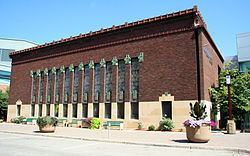Area less than one acre NRHP Reference # 74001004 | Built 1913 Opened 1913 Added to NRHP 30 July 1974 | |
 | ||
MPS Blue Earth County MRA (AD) Similar Lorin Cray House, Renesselaer D Hubbard House, National Farmer's Bank of O, Verizon Wireless Center, Mount Kato | ||
The First National Bank of Mankato, also known as the Old First National Bank of Mankato and located at 229 South Front Street in Mankato, Minnesota, United States, is a fine example of Prairie School architecture in a commercial building, relating rural life to the development of downtown Mankato as a regional center of commerce and finance. The recently restored exterior is now part of the Mankato Civic Center, the Verizon Wireless Center.
Contents
History
Mankato was settled by Whites beginning in 1852, on land previously occupied by the indigenous Sisseton (“Lake Village”) Dakota Sioux until they were forced to cede it under the Treaty of Traverse des Sioux of 1851. Experiencing rapid growth, Mankato sprouted quarries, industries, stores, hotels, and other commercial concerns. "Perhaps most crucial to these businesses, and to the farmers in Blue Earth County, were Mankato’s banks."
The First National Bank of Mankato was one of the three competing financial institutions in the early 20th Century, along with the Citizens’ National Bank and the Mankato State Bank (earlier Mankato National Bank). First National had already been the target of the famous aborted robbery attempt by Jesse James and the James-Younger Gang in 1876, which immediately preceded their defeat at Northfield.
The building eventually built by Ellerbe and Round for the First National Bank involves a likely case of stolen designs. Looking for a new building, First National officials approached Carl K. Bennett of Owatonna, Minnesota, who connected them with the famous Minneapolis-based architectural firm of Purcell and Elmslie in 1912. According to several accounts, Purcell and Elmslie drew extensive sketches for the proposed building which they left with the bank officials. Later informed by mail that the bank would not be using them, they requested that the sketches be returned. The sketches were, but only after a delay of many weeks, during which time the bank hired Ellerbe and Round to be their architects.
It appears that their 1913 design made extensive use of the Purcell and Elmslie sketches. Purcell and Elmslie even received several congratulatory letters from people familiar with their work who had assumed the design was theirs. Although the design closely follows the Purcell and Elmslie design, Ellerbe and Round did eliminate the landscaped forecourt and a deep arch at the front.
Ellerbe and Round would go on to become famous for designing a number of structures for the Mayo Clinic, including the original "Red" Building of 1914.
Originally occupying the prominent corner of Front Street South and West Hickory Street, the First National Bank building was threatened with demolition. Instead, the exterior has been restored and incorporated into the south side of the Verizon Wireless Center as one of the center's event spaces. With that portion of Front Street gone, the restored bank exterior can now be accessed at approximately 105 West Hickory Street.
Architecture
The First National Bank building includes Mankato limestone, brick, and terra cotta in a manner similar to that of the "jewel box" banks of Louis Sullivan or the banks of his former employees, William Gray Purcell and George Elmslie. The brick building's architectural features include Frank Lloyd Wright-inspired stained glass windows and intricate ornamentation at the roof-line.
Even though David Gebhard and Tom Martinson conclude that the resulting building lacks the "liveliness" of a work by Sullivan or by Purcell and Elmslie, they consider it "a good academic exercise in the Prairie Style" and "the most important single building in Mankato."
